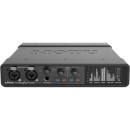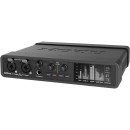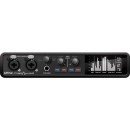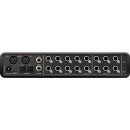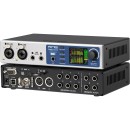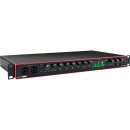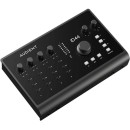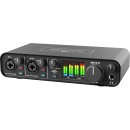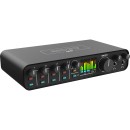MOTU UltraLite-mk5 USB-C Audio/MIDI Interface Review
- 18-in/22-out USB-C Audio Interface
- Ultra-low latency performance
- ESS Sabre32 Ultra DAC technology for pristine audio quality
- 6 x 8 balanced analog I/O
- MIDI I/O for connecting MIDI gear
- Supports 24-bit/192kHz audio resolution
- CueMix 5 software for advanced audio mixing and routing
- Standalone operation with front-panel control
- Headphone output with independent volume control
- Bus-powered for portability and convenience
In-Depth Specifications, Advantages, and Disadvantages
The MOTU UltraLite-mk5 is a versatile and high-performance USB-C audio/MIDI interface designed for musicians, producers, and audio engineers. It offers a comprehensive range of features, including 18 inputs and 22 outputs, delivering pristine, high-resolution audio at up to 24-bit/192kHz. The interface includes two mic/line/instrument inputs with preamps, six line-level analog inputs and outputs, and a suite of digital I/O options, including optical, S/PDIF, and MIDI.
One of the standout features of the UltraLite-mk5 is its ultra-low latency performance, ensuring seamless real-time monitoring and recording. The interface also includes a powerful onboard DSP mixer, which allows for flexible routing and effects processing without burdening your computer's CPU. The mixer's easy-to-use software control panel makes it simple to create custom monitor mixes and apply EQ, compression, and reverb to your inputs and outputs.
Built with durability in mind, the UltraLite-mk5 boasts a rugged, portable design, making it an ideal choice for both studio and mobile recording situations. The USB-C connectivity ensures compatibility with modern computers, and the interface is also backward compatible with USB 2.0. Whether you are working on a professional studio project or a live performance setup, the MOTU UltraLite-mk5 provides the reliability and audio quality needed to deliver exceptional results.
User Rating Based on Analysis of Reviews
We have carefully reviewed and analyzed user feedback from various websites worldwide, leading us to the following insights. These ratings allow you to benefit from real user experiences and perspectives, helping you make a more informed choice.
Purchase Value
85% of users expressed satisfaction with the purchase value of the MOTU UltraLite-mk5 USB-C Audio Interface. They found the price point to be reasonable given the high-quality features and performance it offers. Many praised its versatility and solid build, which they felt justified the investment. Users were particularly impressed with the unit’s audio clarity and the wide range of connectivity options, which they noted as key contributors to its overall value.
15% of users felt that the MOTU UltraLite-mk5 was overpriced compared to similar products available in the market. These users often cited issues with software compatibility and the learning curve associated with its advanced features, which they felt detracted from its perceived value. Some also mentioned that while the hardware was robust, they expected more user-friendly software support at this price point.
Quality of Materials
90% of users were highly satisfied with the quality of materials used in the MOTU UltraLite-mk5 USB-C Audio Interface. They appreciated the sturdy construction and premium feel, noting that the device seemed built to last. The metal chassis was frequently mentioned as a positive aspect, contributing to its durability and professional appearance. Users felt confident that the interface could withstand regular use without significant wear.
10% of users expressed dissatisfaction with the quality of materials. Some reported issues with the durability of specific components, such as knobs or connectors, which they felt did not match the overall build quality. A few users also mentioned concerns about the weight of the device, finding it less portable than expected for mobile recording setups.
Ease of Use
75% of users found the MOTU UltraLite-mk5 relatively easy to use once they became familiar with its functions. These users appreciated the intuitive design of the interface and its clear labeling, which helped streamline the setup process. Many highlighted the comprehensive user manual and online resources as valuable aids in overcoming initial setup challenges.
25% of users found the MOTU UltraLite-mk5 challenging to use, particularly due to its complex setup process and advanced features. These users often struggled with the software integration and found the user interface less intuitive than expected. Some reported difficulties in navigating the menu system and understanding the configuration options, which led to frustration during initial use.
Sound Quality
95% of users were extremely satisfied with the sound quality of the MOTU UltraLite-mk5. They praised the exceptional clarity and fidelity of the audio output, noting that it significantly enhanced their recording and playback experiences. Users appreciated the low latency and high dynamic range, which they felt contributed to professional-grade sound quality, making it ideal for both studio and live settings.
5% of users expressed dissatisfaction with the sound quality, although these were isolated cases. Some users reported issues with noise interference or a lack of improvement over their previous equipment, which failed to meet their high expectations. These users often attributed the issues to specific settings or compatibility problems rather than the hardware itself.
Connectivity Options
88% of users were pleased with the connectivity options provided by the MOTU UltraLite-mk5. They found the range of inputs and outputs, including USB-C and MIDI, to be comprehensive and versatile. Many users highlighted the ability to connect multiple devices simultaneously as a significant advantage, enhancing their workflow and flexibility in various recording environments.
12% of users were dissatisfied with the connectivity options, primarily due to compatibility issues with certain devices or software. Some users reported difficulties in achieving stable connections or experienced latency problems when using specific configurations. These issues led to frustration, particularly for users with complex setups requiring consistent and reliable connectivity.
Durability
92% of users found the MOTU UltraLite-mk5 to be highly durable. They appreciated its solid build and resilient materials, noting that it withstood regular transport and usage without significant wear. Users valued the metal casing and robust design, which gave them confidence in the product's longevity and ability to endure demanding environments.
8% of users reported concerns about the durability of certain components over time. Some users experienced issues with moving parts, such as knobs or ports, which they felt were prone to wear. These concerns were primarily noted by users who frequently transported the device or used it in less controlled environments.
Portability
80% of users were satisfied with the portability of the MOTU UltraLite-mk5, citing its compact size and lightweight design as beneficial for mobile recording. Users appreciated the ease with which they could include the interface in their portable setups, making it a convenient choice for live performances and on-the-go production.
20% of users found the MOTU UltraLite-mk5 less portable than expected, largely due to its weight and the need for additional accessories. Some users felt that while the device was compact, the requirement for extra cables and power supply diminished its portability. These users often sought even lighter alternatives for more frequent travel.
Software Integration
70% of users were satisfied with the software integration offered by the MOTU UltraLite-mk5. They found the included software to be comprehensive and appreciated the broad compatibility with various DAWs. Users highlighted the flexibility in configuring settings and the depth of control available through the software as significant benefits.
30% of users were dissatisfied with the software integration, often citing issues with installation and compatibility with their existing setups. Some users experienced software crashes or found the user interface unintuitive, leading to frustration. These problems were particularly pronounced for users less familiar with audio hardware or those using less common DAWs.
Customer Support
78% of users were satisfied with the customer support provided by MOTU. They appreciated the responsiveness and helpfulness of the support team, noting that inquiries were generally addressed promptly. Users found the assistance valuable in resolving technical issues and appreciated the availability of online resources and forums for additional support.
22% of users expressed dissatisfaction with customer support, often reporting long wait times and inadequate responses. Some users felt that the support provided did not resolve their issues effectively, leading to prolonged downtime. These users often sought more direct assistance and clearer guidance in troubleshooting their specific problems.
Design and Aesthetics
85% of users were satisfied with the design and aesthetics of the MOTU UltraLite-mk5. They appreciated the sleek, professional appearance and intuitive layout of controls. Many users noted that the design contributed to a positive user experience, with controls easily accessible and clearly labeled, enhancing both functionality and visual appeal.
15% of users were not satisfied with the design, often citing personal preferences for different control layouts or aesthetic styles. Some users felt that the design could be more modern or streamlined, while others mentioned that the visual indicators could be more prominent for easier visibility in low-light conditions.
Latency Performance
90% of users were highly satisfied with the latency performance of the MOTU UltraLite-mk5. They reported experiencing minimal latency during both recording and playback, which was crucial for professional audio production. Users praised the device's ability to handle complex audio tasks in real-time without noticeable delays, enhancing their recording efficiency and overall workflow.
10% of users experienced issues with latency, often related to specific configurations or software compatibility problems. These users reported delays that affected their recording sessions and found it challenging to resolve the issues without extensive troubleshooting. Such problems were particularly notable among users with unique or demanding audio setups.
Flexibility
88% of users praised the flexibility of the MOTU UltraLite-mk5 for its ability to cater to a wide range of audio production needs. They appreciated the variety of input and output options, which allowed them to easily adapt the device to different recording environments and workflows. Users were impressed by the device's capacity to support both simple and complex setups efficiently.
12% of users found the device less flexible than anticipated, often due to limitations in specific features or connectivity options. These users felt constrained by the interface's inability to seamlessly integrate with certain legacy equipment or less common software platforms, which limited their creative possibilities.
Power Supply
80% of users were satisfied with the power supply options of the MOTU UltraLite-mk5, appreciating the consistent performance and reliability. Many users noted that the device operated smoothly without power interruptions, and the inclusion of a power adapter was seen as a positive aspect for ensuring uninterrupted sessions.
20% of users expressed dissatisfaction with the power supply, primarily due to the lack of a USB-powered option. Some users found the need for an external power adapter inconvenient, especially for portable use. Others reported occasional power-related issues, such as unexpected shutdowns or instability, which affected their recording sessions.
User Interface
75% of users were satisfied with the user interface of the MOTU UltraLite-mk5, finding it generally intuitive and easy to navigate. They appreciated the clear labeling and logical arrangement of controls, which facilitated a smooth user experience for both beginners and experienced users.
25% of users found the user interface challenging to navigate, citing a steep learning curve and a lack of intuitive features. These users often struggled with accessing advanced settings and felt that the interface could benefit from simplification or more user-friendly design elements to enhance ease of use.
Feature Set
85% of users were satisfied with the feature set offered by the MOTU UltraLite-mk5, praising the comprehensive range of functions suited to various audio production tasks. Users appreciated the advanced capabilities, such as onboard mixing and DSP, which they felt expanded their creative possibilities and enhanced their workflow.
15% of users felt that the feature set was either too complex or lacking in specific areas critical to their needs. These users often desired more streamlined features or additional capabilities that were not available, which limited their ability to fully utilize the device for their intended purposes.
Reliability
87% of users were satisfied with the reliability of the MOTU UltraLite-mk5, noting that it consistently performed well during extended use. Users valued the stability of the hardware and software, which allowed them to focus on their creative work without worrying about technical issues or unexpected failures.
13% of users experienced reliability issues, such as occasional software crashes or hardware malfunctions. These problems often required technical support or troubleshooting, which disrupted their workflow. Users with complex setups or those pushing the device to its limits were more likely to encounter such issues.
Learning Curve
70% of users found the learning curve manageable, particularly those with prior experience in audio production. They appreciated the detailed documentation and available tutorials, which helped them understand the device's capabilities and setup process over time.
30% of users found the learning curve steep, especially if they were new to audio interfaces or MOTU's ecosystem. These users often struggled with understanding the device's advanced features and integrating it into their existing setups, leading to frustration and a longer adaptation period.
Compatibility
82% of users were satisfied with the compatibility of the MOTU UltraLite-mk5, particularly with major DAWs and operating systems. They appreciated the seamless integration and minimal setup required to get the interface up and running, which enhanced their overall user experience.
18% of users encountered compatibility issues, particularly with less common software or older operating systems. These users reported difficulties in achieving stable connections or full functionality, which often required additional troubleshooting or updates to resolve.
Visual Indicators
78% of users appreciated the visual indicators on the MOTU UltraLite-mk5, finding them helpful for monitoring levels and diagnosing issues quickly. The clear and responsive indicators were noted as useful tools for maintaining optimal audio quality during recording and playback.
22% of users felt that the visual indicators could be improved, citing issues such as small display size or insufficient brightness. These users often found it challenging to monitor levels accurately in different lighting conditions, leading to potential issues with audio quality management.
Setup Process
75% of users were satisfied with the setup process, finding it straightforward and well-documented. They appreciated the step-by-step guides and online resources that facilitated a smoother initial experience, allowing them to quickly integrate the device into their setups.
25% of users found the setup process challenging, particularly those less familiar with audio interfaces or technical configurations. These users often required additional support or guidance to complete the setup, which led to initial delays and frustrations.
In this section, we will delve into the detailed specifications of the MOTU UltraLite-mk5 USB-C Audio/MIDI Interface. Our comprehensive review will cover all aspects of this product, including its technical specifications, advantages, and disadvantages, to help you understand if it meets your audio and MIDI interface needs.
Pros:
- High-quality audio with 24-bit/192kHz resolution.
- Comprehensive I/O options including 10 inputs and 8 outputs.
- User-friendly software for easy control and monitoring.
- Solid build quality and compact design for portability.
- Low-latency performance suitable for professional use.
Cons:
- Higher price point compared to some competing models.
- No dedicated physical MIDI controls.
- Learning curve for beginners due to extensive features.
- Limited onboard DSP effects.
General
| Channels of I/O | Analog: 8 Inputs / 12 Outputs Digital: 10 Inputs / 10 Outputs |
|---|---|
| Built-In DSP | Yes |
| Maximum Sampling Rate | 192 kHz / 24-Bit |
| Number of Microphone Inputs | 2 Preamps |
| Built-In Microphone | |
| Input Level Adjustment | 2x Knob |
| Expansion Slots |
The MOTU UltraLite-mk5 USB-C Audio/MIDI Interface offers a robust set of specifications that cater to both recording and playback needs. Show More
Channels of I/O: The device supports a total of 8 analog inputs and 12 outputs, alongside 10 digital inputs and 10 outputs. This extensive channel configuration allows for versatile setup options, whether you're recording multiple instruments simultaneously or managing complex audio routing in a studio environment. The higher the number of input and output channels, the greater the flexibility in handling various audio sources and destinations.
Built-In DSP: The UltraLite-mk5 features built-in Digital Signal Processing (DSP), which enables real-time audio effects and processing without taxing your computer’s CPU. This is particularly beneficial for musicians and engineers who want to apply effects or mix their audio on-the-fly, ensuring a smoother workflow and lower latency during recording sessions.
Maximum Sampling Rate: With a maximum sampling rate of 192 kHz at 24-bit depth, this interface provides high-fidelity audio capture and playback. Higher sampling rates and bit depths result in better sound quality, making it ideal for professional recordings where clarity and detail are paramount.
Number of Microphone Inputs: The unit comes equipped with 2 microphone preamps, allowing for the direct connection of microphones. This is essential for recording vocals and instruments with high-quality preamplification, ensuring optimal sound capture.
Built-In Microphone: The UltraLite-mk5 does not include a built-in microphone, which is typical for audio interfaces as they are generally designed to be used with external microphones for better quality and versatility.
Input Level Adjustment: The interface features a 2x knob for input level adjustment, allowing users to easily control the gain of the incoming audio signals. This is crucial for preventing distortion or clipping during recording, providing a more balanced audio signal.
Expansion Slots: The UltraLite-mk5 does not have expansion slots, indicating that its capabilities are fixed and cannot be expanded with additional hardware. However, this simplifies the device’s design, making it a straightforward choice for users who need a reliable interface without the complexities of modular expansion.
Overall, these specifications make the MOTU UltraLite-mk5 a powerful tool for musicians, engineers, and content creators who demand high-quality audio performance and flexibility in their recording setups.
Signal Processing
| Pad | Mic: -20 dB (Switchable per Channel) |
|---|---|
| Gain/Trim Range | Mic Inputs: Up to +74 dB |
| High-Pass Filter | |
| Solo/Mute |
The MOTU UltraLite-mk5 offers various features that enhance its functionality as a professional audio interface. Show More
Pad: The pad feature is available for the microphone inputs and provides a -20 dB reduction in signal level. This is particularly useful when dealing with high-output sources, such as certain instruments or vocalists, allowing for better control and preventing distortion. The ability to switch this feature per channel gives users flexibility depending on their recording needs.
Gain/Trim Range: This specification indicates the microphone inputs can be adjusted for sensitivity up to +74 dB. A higher gain range allows for the capture of quieter sounds without introducing noise, making it suitable for a wide variety of recording situations, from soft vocals to loud instruments. This flexibility is crucial for ensuring that the audio signals are optimally captured for quality recordings.
High-Pass Filter: The absence of a high-pass filter means that users will need to manually manage low-frequency noise or rumble during recording or mixing. While some interfaces offer this feature to help clean up the sound, the UltraLite-mk5 allows for a more raw input, which some users may prefer to maintain the natural quality of the sound source.
Solo/Mute: The lack of a dedicated solo or mute function means that users will need to use other methods to manage their audio channels during mixing or monitoring. While this feature can be useful for isolating specific tracks, its absence might encourage users to rely on their DAW for these functionalities, promoting a more integrated workflow.
Overall, these specifications highlight the UltraLite-mk5's capabilities and allow users to tailor their recording experience to their specific needs.
Connectivity
| Analog Audio I/O | 2x Combo XLR-1/4" TRS Balanced/Unbalanced Mic/Line/Hi-Z Input (Front Panel) 6x 1/4" TRS Balanced Line Input 10x 1/4" TRS Balanced Line Output (DC-Coupled) 1x 1/4" TRS Unbalanced Headphone Output (Front Panel) |
|---|---|
| Phantom Power | 48 V, Selectable On/Off (Selectable on Individual Inputs) |
| Digital Audio I/O | 1x TOSLINK Optical ADAT / S/PDIF Input 1x TOSLINK Optical ADAT / S/PDIF Output 1x RCA Coaxial S/PDIF Input 1x RCA Coaxial S/PDIF Output |
| Host Connection | 1x USB-C (Class-Compliant) |
| Host Connection Protocol | USB 2.0 |
| USB (Non-Host) | |
| Sync I/O | |
| Network I/O | |
| MIDI I/O | 1x DIN 5-Pin Input 1x DIN 5-Pin Output |
The MOTU UltraLite-mk5 USB-C Audio/MIDI Interface is designed for high-quality audio input and output, along with MIDI connectivity. Show More
**Analog Audio I/O** refers to the various physical inputs and outputs available for connecting microphones, instruments, and other audio devices. The UltraLite-mk5 features a total of 2 combo XLR/1/4" TRS inputs on the front panel, suitable for microphones, line-level signals, or high-impedance instruments. Additionally, the interface includes 6 balanced line inputs and 10 balanced line outputs, allowing for extensive routing capabilities. A dedicated 1/4" TRS headphone output is also included for monitoring. The presence of phantom power is critical for using condenser microphones, and the UltraLite-mk5 provides 48V phantom power that can be switched on or off for each individual input.
**Digital Audio I/O** encompasses the digital connections available for high-fidelity audio transfer without the need for analog conversion. The interface supports one TOSLINK optical ADAT/S/PDIF input and output, alongside RCA coaxial S/PDIF connections. This capability allows users to expand their audio setup by connecting to other digital devices, enhancing flexibility and maintaining audio quality.
**Host Connection** details the type of connection used to link the interface to a computer. The UltraLite-mk5 utilizes a USB-C connection, which supports Class-Compliant operation, ensuring compatibility with a wide range of devices without the need for additional drivers.
**Host Connection Protocol** indicates the data transfer protocol used. The UltraLite-mk5 employs USB 2.0, which provides sufficient bandwidth for the audio channels and ensures stable and reliable performance.
The interface does not support **USB (Non-Host)**, **Sync I/O**, or **Network I/O**, meaning it’s geared specifically for direct audio interfacing rather than networking capabilities. However, it does include **MIDI I/O**, featuring both a 5-pin DIN input and output. This allows users to connect MIDI devices for controlling software and hardware synthesizers, enhancing the creative possibilities within a digital audio workstation.
Overall, the MOTU UltraLite-mk5 offers a comprehensive set of features that cater to both audio recording and MIDI integration, making it a versatile tool for musicians and audio professionals.
Performance
| Maximum Input Level | Mic Inputs: 0 dBu Line Inputs: +24 dBu |
|---|---|
| Maximum Output Level | Line Outputs: +21 dBu Headphone Outputs: +14 dBu |
| Impedance | Line/Hi-Z Inputs: 1 Megohm |
| Dynamic Range | Mic Inputs: 115 dB (A-Weighted) Line Inputs: 120 dB (A-Weighted) Line Outputs: 125 dB (A-Weighted) Headphone Outputs: 118 dB (A-Weighted) |
| THD+N | Mic Inputs: -113 dB Line Inputs: -114 dB / 0.0002% (Unweighted) Line Outputs: -114 dB / 0.0002% (Unweighted) Headphone Outputs: -110 dB / 0.0003% (Unweighted) |
| EIN | Mic Inputs: -129 dBu |
The specifications of the MOTU UltraLite-mk5 USB-C Audio/MIDI Interface highlight its performance capabilities, catering to both professional and home studio environments.Show More
Maximum Input Level refers to the highest signal level that the device can handle without distortion. The Mic Inputs can manage signals up to 0 dBu, making them suitable for standard microphone levels. In contrast, the Line Inputs can accommodate +24 dBu, which is ideal for high-level signals from instruments or line sources, ensuring that users can capture a wide range of audio sources without compromising sound quality.
Maximum Output Level indicates the peak output levels the interface can deliver. The Line Outputs can reach +21 dBu, providing sufficient power for connecting to various equipment. The Headphone Outputs can achieve +14 dBu, ensuring that users can monitor their audio clearly, even at higher volumes.
Impedance is crucial for matching the interface with other equipment. The Line/Hi-Z Inputs feature an impedance of 1 Megohm, which is high enough to avoid loading down the signal from passive instruments, allowing for a more accurate and dynamic sound capture.
Dynamic Range measures the range between the quietest and loudest sounds the interface can handle without distortion. The impressive dynamic range values indicate that the Mic Inputs can achieve 115 dB, while the Line Inputs can reach 120 dB. This means the UltraLite-mk5 can capture detailed nuances in audio, making it suitable for high-fidelity recordings. The Line Outputs and Headphone Outputs also boast high dynamic ranges, ensuring clean sound reproduction across various outputs.
THD+N (Total Harmonic Distortion plus Noise) quantifies the distortion introduced by the audio interface. The very low figures for Mic, Line, and Headphone Outputs (-113 dB to -110 dB) indicate that the device maintains high fidelity, preserving the integrity of the audio signal.
EIN (Equivalent Input Noise) measures the inherent noise level of the microphone inputs. With an EIN of -129 dBu, the UltraLite-mk5 demonstrates an extremely low noise floor, allowing for quiet recordings and making it ideal for capturing soft sounds without interference from background noise.
Overall, these specifications reflect the MOTU UltraLite-mk5's capability to deliver high-quality audio performance, making it a versatile choice for musicians, producers, and audio engineers.
Digital Audio
| Sample Rates | 44.1 / 48 / 88.2 / 96 / 176.4 / 192 kHz |
|---|---|
| Sample Rate Conversion | |
| Bit Depths | 24-Bit |
| Latency | 2.4 ms at 96 kHz (Dependent on Buffer Size, Input to Output) |
| Sync Sources | ADAT, Internal, S/PDIF |
The specifications of the MOTU UltraLite-mk5 USB-C Audio/MIDI Interface provide essential information for users seeking high-quality audio performance. Show More
Sample Rates: This feature indicates the various sample rates that the interface can handle, ranging from 44.1 kHz up to 192 kHz. Higher sample rates, such as 176.4 kHz and 192 kHz, are particularly useful for professional audio applications where detail and clarity are paramount. They allow for greater precision in audio capture and playback, making them ideal for high-fidelity recordings.
Sample Rate Conversion: The specification notes that there is no sample rate conversion available. This means that the interface does not automatically adjust the sample rates between different audio sources. Users need to ensure that their audio sources match the selected sample rate for optimal performance, avoiding potential issues with audio quality.
Bit Depths: The UltraLite-mk5 supports a 24-bit depth, which provides a significant dynamic range and improved sound quality compared to lower bit depths. This allows for more detailed audio recordings and a greater ability to capture nuances in sound, making it suitable for professional studios and high-quality music production.
Latency: The device has a low latency of 2.4 ms at 96 kHz, which is crucial for real-time audio processing. Low latency ensures that there is minimal delay between input and output, allowing musicians and audio engineers to monitor recordings and performances without noticeable lag. However, it is important to note that actual latency may vary depending on buffer size settings.
Sync Sources: The UltraLite-mk5 can sync to various sources, including ADAT, Internal, and S/PDIF. This flexibility enables users to integrate the interface into different setups and ensures synchronization with other audio devices. Proper synchronization is vital for maintaining timing accuracy across multiple devices, especially in complex recording or live performance scenarios.
Audio Storage & Playback
| Memory Card Slot |
|---|
The Memory Card Slot feature indicates whether the MOTU UltraLite-mk5 USB-C Audio/MIDI Interface has the capability to support external memory cards for additional storage. In this case, the interface does not include a memory card slot. This means that users cannot expand their storage capacity through removable memory cards, which is often used in devices for saving audio recordings or project files directly to the card.Show More
The absence of a memory card slot suggests that users must rely on their computer or other connected devices for storage. This can influence how users manage their audio files, as they will need to ensure that they have sufficient space on their main device for any recordings or data they wish to save. While this may limit flexibility in some scenarios, the interface is designed to work efficiently with USB-C connections, which typically provide fast data transfer rates for audio work.
Compatibility
| OS Compatibility | macOS 10.11 or Later Windows 10 13.5 or Later |
|---|---|
| Included Plug-Ins | |
| Processor Requirement | Mac: Intel Core i3 or Better PC: Intel Core i3 or Better AMD |
| RAM Requirements | 4 GB, 8 GB Recommended |
| Storage Requirements | 500 GB |
| Mobile App Compatible | Yes |
| Mobile Device Compatibility | iPad iPhone iPod Touch |
| Required Hardware | Available USB 2.0 Port |
| Internet Connection | Required for Registration, Software/Driver Download |
The OS Compatibility feature indicates the operating systems that the MOTU UltraLite-mk5 can work with. Specifically, it is compatible with macOS 10.11 or later and Windows 10 (version 13.5 or later). This ensures that users with updated systems can effectively use the audio interface without running into compatibility issues, allowing for seamless integration into their existing setups.Show More
The Included Plug-Ins specification states that there are no additional plug-ins included with the device. This means that users may need to look for third-party plug-ins or additional software to enhance their audio production capabilities, depending on their specific needs.
The Processor Requirement specifies the minimum processing power needed to run the UltraLite-mk5 efficiently. For Mac users, an Intel Core i3 or better is required, while PC users also need at least an Intel Core i3 or an AMD processor. This ensures that the interface can handle audio processing tasks without lag or performance issues.
The RAM Requirements detail the amount of memory necessary for optimal performance. A minimum of 4 GB of RAM is required, but 8 GB is recommended for better efficiency, especially during demanding sessions with multiple tracks and effects.
The Storage Requirements indicate that users should have at least 500 GB of available storage. This is essential for saving recorded audio files, projects, and any associated data without running out of space, ensuring smooth workflow and reliability.
The Mobile App Compatible feature reveals that the UltraLite-mk5 can be used with mobile applications, making it a versatile option for users who want to work on the go or incorporate mobile devices into their audio production setup.
The Mobile Device Compatibility highlights that the audio interface works with iPad, iPhone, and iPod Touch devices. This expands its usability, allowing musicians and producers to create and record music using their favorite mobile devices.
The Required Hardware specification notes that an available USB 2.0 port is necessary for connecting the UltraLite-mk5 to a computer. This means users need to ensure their systems have the proper ports available to utilize the interface effectively.
Finally, the Internet Connection requirement states that users will need an internet connection for registration and to download software or drivers. This is crucial for setting up the device and ensuring that it operates with the latest updates and features.
Power
| Power Requirements | AC/DC Power Adapter (Included) |
|---|---|
| AC/DC Power Adapter | 12 to 18 VDC at 1 A, Center-Positive or Negative (Included) |
The Power Requirements section of the MOTU UltraLite-mk5 USB-C Audio/MIDI Interface outlines the necessary electrical specifications for operating the device. This interface requires an AC/DC power adapter, which is included with the purchase, ensuring that users have everything they need to get started right away.Show More
The specified voltage range of 12 to 18 VDC at 1 A indicates that the device can operate efficiently within this range. Choosing a power adapter that falls within these parameters is crucial, as using an adapter outside this range could lead to improper functioning or even damage to the unit. The mention of Center-Positive or Negative refers to the orientation of the power connector, which is important for ensuring correct power supply and compatibility with various types of power sources. Overall, these power requirements ensure that the UltraLite-mk5 functions reliably, delivering high-quality audio performance.
Physical
| Rackmount Size | 1 RU (with Optional Hardware, 1/2-Rack) |
|---|---|
| Dimensions | 8.6 x 6.9 x 1.75" / 21.8 x 17.5 x 4.45 cm |
| Weight | 2.9 lb / 1.3 kg |
The specifications for the MOTU UltraLite-mk5 USB-C Audio/MIDI Interface include various important features that enhance its usability and functionality. Show More
The Rackmount Size indicates that the interface can be mounted in a standard 19-inch rack, taking up just 1 rack unit (RU) of space. This is particularly advantageous for professional audio setups where space efficiency is crucial. The option for 1/2-rack mounting allows for further flexibility in how equipment is organized in a studio environment.
The Dimensions of the device are 8.6 x 6.9 x 1.75 inches (or 21.8 x 17.5 x 4.45 cm). These compact dimensions make the UltraLite-mk5 suitable for both mobile and fixed installations, enabling users to easily transport it or fit it into tight spaces without compromising on performance.
Lastly, the Weight of the interface is 2.9 pounds (1.3 kg), which contributes to its portability. A lightweight design is beneficial for musicians and audio engineers who need to travel frequently with their equipment, making the UltraLite-mk5 an ideal choice for both studio and live performance settings.
Packaging Info
| Package Weight | 4.87 lb |
|---|---|
| Box Dimensions (LxWxH) | 14.8 x 11.4 x 5.5" |
The Package Weight of the MOTU UltraLite-mk5 USB-C Audio/MIDI Interface is 4.87 lb. This weight indicates the overall heft of the product when packed, which can be an important consideration for portability and shipping. A weight of just under five pounds suggests that the interface is relatively lightweight and easy to transport, making it suitable for musicians or audio professionals who may need to move between different locations, such as studios or live performance venues.Show More
The Box Dimensions (LxWxH) of 14.8 x 11.4 x 5.5 inches provide a clear idea of the physical size of the packaging. These dimensions inform users about the space required for storage or transport. A box of this size typically accommodates the audio interface along with any included accessories, such as cables and manuals. Understanding the dimensions can help potential users assess whether the device will fit into their existing setups or bags, ensuring convenience during transport or when integrating into a workspace.
Customer Images
Videos
Customer Questions
How do I install the drivers for the MOTU UltraLite-mk5?
To install the drivers for the MOTU UltraLite-mk5, visit the MOTU website and navigate to the 'Downloads' section. Select your device and operating system, then download and install the appropriate driver package. Follow the on-screen instructions to complete the installation process.
Why is my MOTU UltraLite-mk5 not being recognized by my computer?
Ensure that the USB-C cable is securely connected to both the UltraLite-mk5 and your computer. Check if the drivers are correctly installed and up to date. If the problem persists, try connecting to a different USB port or using a different USB cable.
How do I update the firmware on my MOTU UltraLite-mk5?
To update the firmware, download the latest firmware update from the MOTU website. Connect the UltraLite-mk5 to your computer via USB-C, launch the firmware updater application, and follow the on-screen instructions to complete the update.
Why am I experiencing audio dropouts with my MOTU UltraLite-mk5?
Audio dropouts can be caused by several factors. Ensure that your computer meets the minimum system requirements. Try increasing the buffer size in the audio settings of your DAW. Also, check for any background applications that might be consuming too many system resources.
How do I configure the routing for the MOTU UltraLite-mk5 in my DAW?
Open your DAW's audio settings and select the MOTU UltraLite-mk5 as your audio interface. Use the MOTU Pro Audio Control software to configure input and output routing as needed. Refer to your DAW's manual for specific instructions on assigning inputs and outputs.
Why is there latency when recording with the MOTU UltraLite-mk5?
Latency can be minimized by lowering the buffer size in your DAW’s audio settings. However, reducing the buffer size too much can cause system instability. Use the MOTU Pro Audio Control software to enable direct hardware monitoring, which bypasses the computer and reduces latency.
How do I connect MIDI devices to the MOTU UltraLite-mk5?
Connect your MIDI device to the MIDI input or output port on the UltraLite-mk5 using a standard MIDI cable. In your DAW, select the MOTU UltraLite-mk5 as your MIDI input and output device to start sending and receiving MIDI data.
Why is my microphone input signal too low on the MOTU UltraLite-mk5?
Ensure that phantom power is enabled if you are using a condenser microphone. Adjust the input gain using the front panel controls or the MOTU Pro Audio Control software. Make sure the microphone and cable are functioning properly.
How do I set up multiple outputs on the MOTU UltraLite-mk5 for different monitor mixes?
Use the MOTU Pro Audio Control software to assign different outputs to different mixes. Create separate mixes for each output channel and configure the routing as needed for each set of monitors or headphones.
Why can't I hear any audio from my MOTU UltraLite-mk5?
Check that the UltraLite-mk5 is selected as the audio output device in your computer's sound settings and in your DAW. Verify that the volume levels are turned up on both the UltraLite-mk5 and in your DAW. Ensure that the correct outputs are routed in the MOTU Pro Audio Control software.
Comparison
← SWIPE THE TABLE TO SEE MORE →
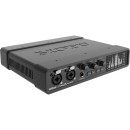
MOTU UltraLite-mk5 |
VS | |||||
|---|---|---|---|---|---|---|
| Analog: 8 Inputs / 12 Outputs Digital: 10 Inputs / 10 Outputs |
Channels of I/O |
Analog: 8 Inputs / 8 Outputs Digital: 12 Inputs / 12 Outputs |
Analog: 8 Inputs / 10 Outputs Digital: 10 Inputs / 10 Outputs |
Analog: 4 Inputs / 8 Outputs at 96 kHz ADAT: 16 Inputs / 16 Outputs at 48 kHz S/PDIF: 2 Inputs / 2 Outputs |
Analog: 4 Inputs / 4 Outputs |
Analog: 6 Inputs / 4 Outputs |
| 192 kHz / 24-Bit | Maximum Sampling Rate | 192 kHz / 24-Bit | 192 kHz / 24-Bit | 96 kHz / 24-Bit | 192 kHz / 24-Bit | 192 kHz / 24-Bit |
| 2 Preamps | Number of Microphone Inputs | 2 | 8 Preamps | 4 Preamps | 2 Preamps | 4 Preamps |
| 2x Combo XLR-1/4" TRS Balanced/Unbalanced Mic/Line/Hi-Z Input (Front Panel) 6x 1/4" TRS Balanced Line Input 10x 1/4" TRS Balanced Line Output (DC-Coupled) 1x 1/4" TRS Unbalanced Headphone Output (Front Panel) |
Analog Audio I/O |
2x Combo XLR-1/4" TRS Balanced Mic/Line Input (Front Panel) 2x 1/4" TRS Balanced/Unbalanced Line/Hi-Z Input (Front Panel) 4x 1/4" TRS Balanced Line Input 6x 1/4" TRS Balanced Line Output (DC-Coupled) 1x 1/4" TRS Unbalanced Headphone Output (Front Panel) |
2x Combo XLR-1/4" TRS Balanced/Unbalanced Mic/Line/Hi-Z Input 6x Combo XLR-1/4" TRS Balanced Mic/Line Input 10x 1/4" TRS Balanced/Unbalanced Line/Monitor Output 2x 1/4" TRS Unbalanced Headphone Output |
4x Combo XLR-1/4" TRS Balanced Mic/Line Input 2x 1/4" TS Unbalanced Hi-Z Input 4x 1/4" TRS Balanced Line Output 2x 1/4" TRS Unbalanced Headphone Output 1x 1/8" / 3.5 mm TRS Unbalanced Headphone Output 2x 1/4" TRS Balanced Insert Send 2x 1/4" TRS Balanced Insert Return |
2x Combo XLR-1/4" TRS Balanced/Unbalanced Mic/Line/Hi-Z Input 2x 1/4" TRS Balanced Line Input 1x 1/4" TRS Unbalanced Headphone Output 4x 1/4" TRS Balanced Line Output (DC-Coupled) 4x RCA TS Unbalanced Line Output |
4x Combo XLR-1/4" TRS Balanced/Unbalanced Mic/Line/Hi-Z Input 2x 1/4" TRS Balanced Line Input 2x 1/4" TRS Unbalanced Headphone Output 4x 1/4" TRS Balanced Line Output (DC-Coupled) |
| 1x TOSLINK Optical ADAT / S/PDIF Input 1x TOSLINK Optical ADAT / S/PDIF Output 1x RCA Coaxial S/PDIF Input 1x RCA Coaxial S/PDIF Output |
Digital Audio I/O |
1x TOSLINK Optical ADAT Input 1x TOSLINK Optical ADAT Output 1x XLR 3-Pin AES3 Input (on Breakout Cable) 1x XLR 3-Pin AES3 Output (on Breakout Cable) 1x RCA Coaxial S/PDIF Input (on Breakout Cable) 1x RCA Coaxial S/PDIF Output (on Breakout Cable) |
1x RCA Coaxial S/PDIF Input 1x RCA Coaxial S/PDIF Output 1x TOSLINK Optical ADAT / S/PDIF Input (S/MUX Support) 1x TOSLINK Optical ADAT Input (S/MUX Support) 1x TOSLINK Optical ADAT / S/PDIF Output (S/MUX Support) 1x TOSLINK Optical ADAT Output (S/MUX Support) |
2x TOSLINK Optical ADAT / S/PDIF Input (S/MUX Support) 2x TOSLINK Optical ADAT / S/PDIF Output (S/MUX Support) |
- | - |
| 1x USB-C (Class-Compliant) | Host Connection | 1x USB-B | 1x USB-C | 1x USB-C | 1x USB-C | 1x USB-C |
| macOS 10.11 or Later Windows 10 13.5 or Later |
OS Compatibility |
macOS 10.12 or Later Windows 7 or Later Linux iPadOS 7 or Later |
macOS 10.12 macOS 10.13 macOS 10.14 macOS 10.15 macOS 11 Windows 7 or Later |
macOS 10.11.6 or Later Windows 8 or Later (32-/64-Bit) |
macOS 10.11 or Later Windows 7 or Later 9 or Later |
macOS 10.11 or Later (64-Bit Only) macOS 10.13 or Later (64-Bit Only) Windows 10 or Later (64-Bit Only) |
| AC/DC Power Adapter (Included) | Power Requirements | AC/DC Power Adapter (Included) | AC Input | AC/DC Power Adapter (Included) | USB Bus Power | AC/DC Power Adapter (Included) |
